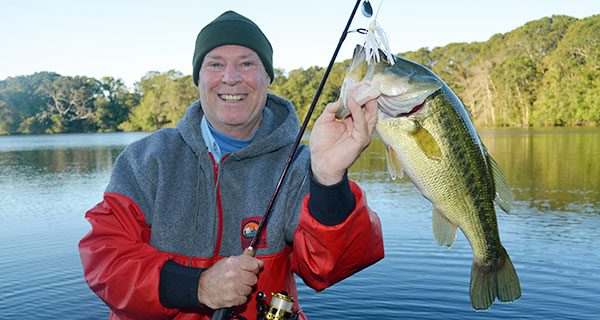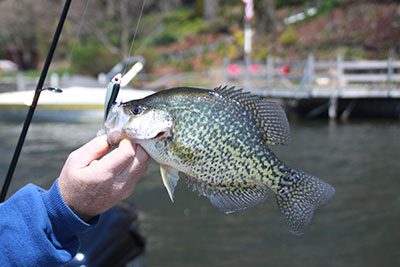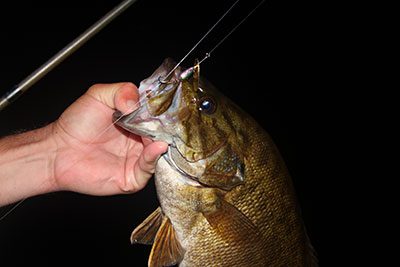
By Tom Schlichter
Despite all the hoopla about how good fall fishing can be, shallow lakes and ponds have a reputation for frustrating even veteran anglers once October rolls around. The reason is fairly simple; just as shallow waters are the first to warm up in the springtime, they are the first to cool down when the air grows crisp.
Having less depth to hold the heat than large impoundments, reservoirs, kettle holes and rivers, shallow dishpan ponds in particular can lose their edge a full month before these deeper bodies of water. Thus, you’ve got to start fishing in these shallow environs as though it’s winter-time long before the coldest winds arrive. Following are several tips for stretching your hawg bass season until the leaves have all dropped from the trees.
Realize That “Deep” Is A Relative Term
The book on cold weather bass fishing says to look for the deepest water you can find. In a lake with a max depth of six feet or eight feet, however, this approach is probably futile. Oh, there’s no doubt some bass will try to hold right on the bottom but in many mill ponds that would be right in front of the dam. In such places, there is little in the way of protection from the sun and, should a bass stay there for very long, it will be easily discovered by prospecting anglers or the neighborhood youth.
Instead of simply looking for the deepest water in the lake, look for pockets or channels that might give you an extra foot or two of depth compared to the surrounding area. While a five-foot deep pocket that’s a bit off the beaten track might not offer the deepest water in the lake, you can bet that it will be more productive than a ten-foot hole right in front of the outflow dam once the water turns gin-clear. Drop-offs that lie just outside of shallow coves or flats are great places to begin your prospecting. Old channel beds can also be hot spots, especially if you find a place where they bend.

Don’t Give Up On The Weeds
A second key to keep in mind when targeting fall bass is that bigmouths love weed edges – even as temperatures drop though the fall. Once the shallow weed beds die off in early October, largemouths are forced out into open water and can no longer hide in the network of tunnels that criss-cross beneath the surface. Still, they want to be near cover and they will stay along the edge of any subsurface growth they can find.
The ideal scenario is to find some weed beds that still stand above the bottom in the deepest water you can locate. Look for weeds that continue to show some green. Green weeds are still giving off oxygen into the water and thus, offer yet another reason for the bass to gravitate toward them.
Lighten Up
Because the water is gin-clear at this time of year, light tackle is a must if you want to hook-up with any consistency. For late fall action, I like to break out my four-pound-test spinning outfit. Six-pound test line will take fish also but at eight-pound test the bass definitely begin to shy away. I tend to favor mono at this point in the season due to its lack of visibility in the crisp, cool waters of fall. If you want to stay with your braid, a four- to five-foot fluorocarbon leader is an absolute must.
Simply put, the lighter you go, the more action you should get. Since the weeds this time of year are not much of a factor, and the bass are a bit sluggish when hooked, with a little care you should be able to best even your biggest hook-ups with ultra-light gear.

Go Small For More Action
In terms of lures, there are two primary routes from which to choose. Small lures and baits seem to produce the most action; large ones seem to turn on bigger but far fewer fish.
If you choose the action route, Roostertails and small Mepps or Panther Martin spinners can be quite productive. These should be worked with a moderate, unbroken, retrieve just fast enough to keep them a half-foot off the bottom or above the weeds. Small spoons and spinnerbaits can be worked in the same fashion, although they tend to have a greater chance of picking up weeds.
Small leadhead jigs tipped with plastic grubs, or tube lures, also make great offerings during October. Try n 1/8th-ounce white or fluorescent yellow jighead with a two-inch fluorescent yellow, green or chartreuse curly tail grub and you might catch anything from monster bass and pickerel to tasty crappies and bluegills. Work these as slowly as possible without catching weeds. Cast out, lower your rod, and let the grub sink to within inches of the bottom. Now engage your reel and lift your rod slowly using its length as a pendulum to slide the grub just above the bottom and toward the boat or shore. As the grub comes up toward the surface, lower your rod again and take up the slack. Repeat this process until the grub returns. Hits will sometimes be sharp, but more likely they will register as a light “tap, tap” or simply a heaviness at the end of the line. By the way, the same technique will also work with small plastic worms. Both grubs and worms seem to work best if “scented”.
Fish Big For Big Fish
If you want to target only bigger fish, then fish big. Choose a six or eight-inch black plastic worm, rig it Carolina weedless or wacky worm style, and work it as slowly as possible just above the bottom. If you have a few feet of water to work with, you might also try a big black or chartreuse spinnerbait rolled slowly over the tops of any submerged weed beds.
Because the bass are sluggish this time of year, be sure to work each prospective spot thoroughly. A four-pounder may need to look at your offering several times on consecutive casts before it decides to make a move. The bigger your lure, the slower you need to work it and the more time you need to give the fish to decide to strike. Be patient.
Get Out Early
The bigger bass are likely to be in the same general locations as the smaller ones this time of the year, but they’ll tend to be very finicky. You might think that a trophy largemouth would want to feed at mid-day or in the late afternoon at this point as that is when the water is warmest. My bass fishing experiences, however, have shown consistently that the biggest bass tend to feed best early in the morning. In fact, for me, daybreak until about 9:00 a.m. has been the best big bass time slot from October through April – even when I’m ice-fishing.
Editors’ Note: Catch more of Tom Schlichter’s articles at www.outdoortom.com, or follow Tom on Facebook at: @outdoortomcorp.









